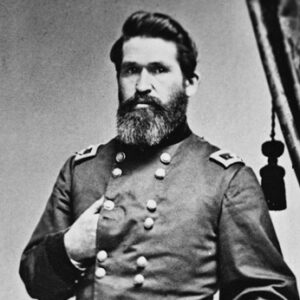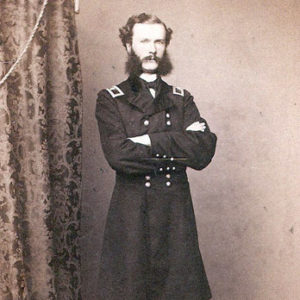calsfoundation@cals.org
Capture of Van Buren
| Location: | Crawford County |
| Campaign: | Prairie Grove Campaign |
| Date: | December 28, 1862 |
| Principal Commanders: | Brigadier General James G. Blunt, Brigadier General Francis J. Herron (US); Major General Thomas C. Hindman (CS) |
| Forces Engaged: | Union Army of the Frontier (US); Confederate Army of the Trans-Mississippi (CS) |
| Estimated Casualties | 1 killed, 5 wounded (US); not reported (CS) |
| Result: | Union victory |
Following the December 7, 1862, Battle of Prairie Grove, Major General Thomas C. Hindman took the Confederate army under his command south of the Boston Mountains. Union generals James G. Blunt and Francis J. Herron rested their troops for three days and then began discussing an expedition toward Van Buren (Crawford County). They planned to take 8,000 of their best troops south and engage Hindman’s army. Six inches of snowfall from a winter storm delayed the generals from putting any plans into action, but they were able to meet to complete plans by Christmas night. They planted stories among their troops that they were going to proceed toward Huntsville (Madison County) so that any spies in the camps would pass on that false information.
As Hindman proceeded south after the Prairie Grove battle, he posted Lieutenant Colonel R. P. Crump with the First Regiment of Texas Partisans at Dripping Springs (Crawford County) nine miles north of Van Buren with instructions to post pickets at all roads leading north. He instructed Colonel Robert Glenn Shaver to operate his Confederate brigade—including Adams’s, Twenty-seventh, Thirty-third, and Thirty-eighth Arkansas Infantry regiments and Roberts’s Missouri Battery—in and around Van Buren. Hindman proceeded across the Arkansas River to Fort Smith (Sebastian County). His troops were demoralized and ill. Because desertions were so great, the depleted troops under Brigadier General John S. Roane, consisting of units from Texas and Arkansas, were broken up and placed with other units.
Hindman assessed the situation in the Fort Smith and Van Buren areas and determined that it was impossible to find subsistence and forage for his men and the horses, so he began to send other divisions to areas along the river east of his current location. By December 28, Confederate brigadier general James F. Fagan and his units were located twenty-five miles downriver, Brigadier General D. M. Frost’s forces were located ten miles away on the road to Little Rock (Pulaski County), and Shaver’s troops were two miles east of Fort Smith on the southern side of the Arkansas River.
On December 27, the 8,000 troops Blunt selected marched from their camp at Rhea’s Mill and struck the Cove Creek Road toward Van Buren. Cove Creek was swollen by snowmelt, and the troops had to wade each crossing, sometimes in waist-deep water. These troops camped for the night, dried their clothes, and resumed their march before daylight the next day. Lieutenant Colonel Owen A. Bassett took the advance with the Second Kansas Cavalry, followed by the Sixth Kansas and the Third Wisconsin Cavalry regiments. By daylight, they struck the Telegraph Road at Dick Oliver’s store, where they halted.
Within a few minutes, the vanguard of Herron’s two divisions came into sight. They had been marching southward on the Telegraph Road from Herron’s camp at Prairie Grove. Their march along the muddy Telegraph Road had also been difficult, with the guns sometimes needing fifty men pulling ropes to get them along the road. Herron and Blunt conferred and headed toward Van Buren on the Telegraph Road, with the vanguard of the Second Kansas and the rest of the troops following.
Road conditions had improved, and travel was much better. Three miles south of Oliver’s store, the Federal advance encountered some of Crump’s Texans on picket. They fired in the air and rode off to alert the rest of the Confederate force at Dripping Springs. Crump, who was in command at Dripping Springs, had no advance warning of the impending attack and had let his troops have a leisurely breakfast. They rushed to mount and ride toward Van Buren. Crump attempted to rally his forces three times as the running fight advanced to the town but was overrun by the Federals each time.
When Blunt and Herron stopped to survey the town at a hill overlooking Van Buren, they discovered that three steamboats and the ferry were leaving the landing. Herron ordered Major Charles Banzhaf to take the First Missouri Cavalry on the road east of town to cut off any attempts of escape in that direction. On learning that the Arkansas River made a sharp bend two miles below the town, Blunt ordered Colonel William F. Cloud to proceed with his brigade and two howitzers to the river bend and attempt to cut off the steamboats. Banzhaf, with his troops, was also headed in that direction.
The steamboat Notrebe had been grounded on a bar before reaching the bend and was abandoned when the Federals took possession. When the advance company led by Captain Irving W. Fuller of Banzhaf’s battalion reached the steamer Rose Douglas, they dismounted and fired at the boat. The captain surrendered and ran the boat to the landing, where it was boarded by the Federals. The steamer Key West had passed the bend, but the captain stopped the boat and was easily convinced to surrender by Fuller’s Missourians. The boat landed at Strain’s landing ten miles below the town, and all three boats were then taken back to the wharf at Van Buren.
A horse-drawn ferry loaded with Confederate soldiers and citizens was halted as it attempted to cross the river by a shot from the Second Kansas Cavalry’s mountain howitzer. The shot killed one of the horses, but as the ferry was close to the southern river bank, the passengers were able to wade ashore.
A galloping courier from Dripping Springs had notified Hindman of the rapidly approaching Union offensive. He ordered the officers in charge of supplies to clear out what they could of the Confederate stores at Van Buren and Fort Smith. He ordered Frost’s division to move to Strain’s landing and Shaver’s brigade to double-time to the river opposite Van Buren. He ordered two steamboats located above Fort Smith, the Eva and the Arkansas, to be unloaded and burned.
Shaver’s Arkansans reached a position opposite Van Buren two and a half hours after the Union troops arrived. West’s Arkansas Battery, with its four six-pounder smoothbores, opened fire on the town. Blunt and Herron, who were aboard one of the captured steamboats at the landing, barely escaped one of the exploding shells. Blunt called up the First Kansas Battery with its four ten-pounder Parrotts to take a position on a hill overlooking Van Buren and return fire. The artillery duel lasted until sunset. Herron was critical of the Confederates for firing at a town filled with women and children.
On the morning of December 29, Blunt planned to cross the river and attack the Confederate troops, but his scouts discovered that the Confederate troops had evacuated Fort Smith, leaving behind 600 sick and wounded soldiers to fend for themselves. Sugar and other supplies the Federal troops had taken from the three captured steamers were loaded in the available wagons, and the wagons and camp supplies that had been taken at Dripping Spring were prepared for transport. The telegraph office in Van Buren was taken over, and several Confederate messages were taken. The three steamboats, the ferry, and 13,000 bushels of corn they could not carry were burned. Blunt determined that it was impossible to maintain his army south of the Boston Mountains. Herron broke camp and moved out that evening, and Blunt moved out the next day. Bassett’s Second Kansas, returning from a scouting mission along the north side of the river as far as Ozark (Franklin County), was the last to leave Van Buren.
For additional information:
Bearss, Edwin C. “The Federals Raid Van Buren and Threaten Fort Smith.” Arkansas Historical Quarterly 69 (Summer 2012): 188–202.
Britton, Wiley. The Civil War on the Border: A Narrative of Operations in Missouri, Arkansas, and Indian Territory during the Years 1861–1862. 3rd ed. New York: G. P. Putman’s Sons, 1899.
Shea, William L. Fields of Blood: The Prairie Grove Campaign. Chapel Hill: University of North Carolina Press, 2009.
The War of the Rebellion: A Compilation of the Official Records of the Union and Confederate Armies. Series I, Vol. 22. Washington DC: Government Printing Office, 1888.
Carolyn Yancey Kent
Jacksonville, Arkansas
 Civil War Timeline
Civil War Timeline Military
Military ACWSC Logo
ACWSC Logo  James Blunt
James Blunt  Francis Herron
Francis Herron  Thomas Hindman
Thomas Hindman 




Comments
No comments on this entry yet.